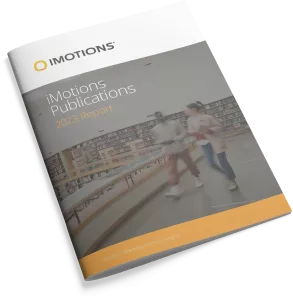-
Automatic Analysis of Eye-Tracking Data for Augmented Reality Applications: A Prospective Outlook
Abstract: Eye-tracking technology is becoming easier and cheaper to use, resulting in its increasing application to numerous fields of research. Recent years have seen rapid developments in this area. In light of the foregoing, in the context of Cultural Heritage (CH), the definition of a modern approach to understand how individuals perceive art is challenging. […]
-
Using Biometric Data to Assess Affective Response to Media Experiences
Abstract: The purpose of this work is to investigate a method of measuring emotional experience by interrupting video content every three minutes to self-report. We let 16 test participants watch the short-film Helium divided into a control group and an intervention group. The subjective experiences from nine subjects (the intervention group) were captured by self-reporting […]
-
Are Pedagogical Agents’ External Regulation Effective in Fostering Learning with Intelligent Tutoring Systems?
Abstract: In this study we tested whether external regulation provided by artificial pedagogical agents (PAs) was effective in facilitating learners’ self-regulated learning (SRL) and can therefore foster complex learning with a hypermedia-based intelligent tutoring system. One hundred twenty (N = 120) college students learned about the human circulatory system with MetaTutor during a 2-hour session under one […]
-
Planning for the Subconscious
Abstract: The world is entering a new era of cognitive science that allows us to understand human behavior better than ever before. In fact, the Organization for Economic Co-Operation and Development recently labelled the 21st century the “Age of Biology,” noting the growing impacts of the ongoing life-science revolution, which the group predicts will change economies, […]
-
Eye-tracking technology, visual preference surveys, and urban design: preliminary evidence of an effective methodology
Abstract: Urban planners and designers use visual preference surveys to gather public opinion on potential designs for developments. Using eye-tracking technology, we administered a visual preference survey to a convenience sample to evaluate quantitatively the ways in which individuals process and rank images used in public settings for urban planning. We combined both a subjective […]
-
Application of Hedonic Dynamics Using Multiple-Sip Temporal-Liking and Facial Expression for Evaluation of a New Beverage
Abstract: Drinking and eating are not a matter of a single sip or bite. Dynamic data gathered from multiple sip or bite, seem to be more reliable than simple sip/bite evaluation. However, methodologies and analyses based on multiple sips/bites have received little attention until recently. The present study tested an innovative approach to measure the […]
-
Introducing the wayfaring approach for the development of human experiments in interaction design and engineering design science
Abstract: This paper introduces a wayfaring process, previously deployed at early stage product development projects, in the exploration, design and piloting of experiments. The case example being an interaction experiment in a ship bridge context, targeting stress and affective response. It included a simulation task as primary and a cognitive load task as secondary element […]
-
Determining Emotions via Facial Expression Analysis Software
Abstract: Facial expression recognition has been a highly researched topic in the field of biometrics for decades. It has been used with the intent of both identifying specific individuals, and in understanding human relations and communication. Grouping these expressions into emotions is a subset of this research, which is still new. The focus of this […]
-
An application of eye tracking technology to detect attention bias for suicide related stimuli
Abstract: Suicide is a leading cause of mortality world-wide, accounting for 1.4% of annual deaths. Traditional risk factors, self-report questionnaires, and clinical interviews have limited predictive validity for short-term suicide attempts. Studies using behavioral measures like the Suicide Implicit Association Test (S-IAT) to detect automatic and unconscious preference towards suicide related stimuli have demonstrated unique […]
-
Does the presence of a mannequin head change shopping behavior?
Mannequins are ubiquitous; this research investigates a specific element of mannequin style, namely, the presence or absence of a humanized head. Study 1 demonstrates that in physical stores, the presence of a humanized head enhances purchase intentions for the merchandise displayed on that mannequin. However, in online stores, mannequin styles with and without humanized heads […]
Research Report 2023
In-depth look at the scientific landscape as powered by iMotions software, showcasing groundbreaking research and the impact of our tools in various scientific and industrial fields.

Share Your Research

850+ universities worldwide with an iMotions human behavior lab
73 of the top 100 highest ranked universities
710+ published research papers using iMotions
iMotions is used for some of the most interesting human behavior research studies carried out by top researchers around the world. Contact us to have your publication featured here.
The authors of these publications have used iMotions as a software tool within their research.
“Software should be cited on the same basis as any other research product such as a paper or a book; that is, authors should cite the appropriate set of software products just as they cite the appropriate set of papers” (Katz et al., 2020).
We therefore encourage you to cite the use of iMotions where appropriate.
How to cite iMotions
APA
iMotions (10), iMotions A/S, Copenhagen, Denmark, (2024).
Note: adjust the version and year where relevant.
5 Most Popular Blogs
Learn How to Conduct Human Behavior Research with iMotions
Publications
Read publications made possible with iMotions
Blog
Get inspired and learn more from our expert content writers
Newsletter
A monthly close up of latest product and research news





